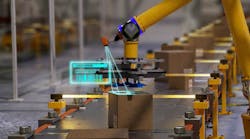Texas Instruments
Sponsored Content
Unlocking Safer, More Efficient Robotics Systems with Advanced Processors
June 24, 2024
Related To:
Members can download this article in PDF format.
The evolution of the microprocessor ecosystem has presented us with a myriad of advanced devices. These devices have added capabilities to robotics that are orders of magnitude beyond those of just a few years ago.
Today’s processors are more complex than ever. The move toward system-on-chip (SoC) architecture has created devices that integrate many, formerly peripheral, components. It’s also added a slew of advanced features, enabled increased efficiency, implemented advanced power management, and integrated intelligent functions—all while reducing the footprint.
These latest SoC iterations can be found across a variety of industrial segments, including the guidance systems of modern mobile robots, the topic of this article.
For smart mobile robots to function in a safe, collaborative, and autonomous fashion, guidance systems with advanced technologies and components are required. Embedded processors, coupled with AI and sensor fusion, enable mobile robots to execute a wide range of new assignments and tasks.
Tangential to all of this, though just as important, is power. With today’s awareness of power conservation, smart power management is a must. This is not only ecologically sound, but it defines the project’s overall power budget. It becomes even more of a critical factor with portable equipment.
To empower this, Texas Instruments developed the AM68A, AM69A, TDA4VM and TDA4VH-Q1 scalable embedded processor family. Paired with AI and sensor fusion, these chips advance the design of safer, more efficient, and highly integrated, modern autonomous robotic systems. These complex devices incorporate a range of functions, including motion and sensor control, data processing, wireless communication, LiDAR, mmWave radar, real-time decision-making, and more.
For example, the AM69A processor, which is the flagship of the series, is packed with four 512-bit C7x digital signal processors (DSPs) running at 1 GHz. Each of these is tightly coupled with each of the four matrix multiplication accelerators (MMAs), capable of 4K, 8-bit fixed multiply-accumulate (MAC) per cycle. The four MMAs can run 32 dense trillion operations per second (TOPS).
The tight integration of this design is necessary to support AI’s deep-learning networks and multiple, complex sensor networks simultaneously—a must for supporting the high level of many of the edge-of-the-envelope applications discussed later. The figure shows a simplified block diagram of AM69A core.
While it’s relatively simple to create autonomous robot navigation functions determined by lanes or tags, dynamic autonomous navigation is another story. More and more, robots need to respond to dynamic environments filled with challenges.
In many cases they must be keenly aware of objects that surround them, such as humans, other robots, mobile equipment, structures, stairs, floor configurations, etc. Thus, they must be sufficiently sophisticated to assess these environments and react, on the fly, to changes in the circumambient space.
Understanding that, TI has developed a tool called “simultaneous localization and mapping” (SLAM). It’s a set of algorithms that allows the mobile robot to explore an unknown environment and update its situation while simultaneously updating map data. It uses both visual (camera) and LiDAR data for input assessment and decision-making. SLAM has three groups of advanced algorithms: filter-based, graph, and deep learning. Of particular interest to this conversation is deep learning.
Deep learning is where the most advanced features of embedded processors, like the AM69A, shine. For the mobile robot to accomplish all of the functions necessary for dynamic movement, the processor must integrate the sophisticated hardware and complex software discussed earlier. To store and manipulate incoming data from many sources demands fast processing, sufficient storage, and multiple layers of neural networks. That’s the only way to ensure safe, precise, and agile ongoing operations in real-time applications.
At some level, all robotic solutions—hospitals, assembly lines, warehouses, transportation, environment, etc.—safety is a priority. While safety is a basic component of the hardware, advanced applications often require additional data to fully realize the required safety standards and certifications.
TI is keenly aware of this and has a vast array of safety resources. The Jacinto Functional Safety Enablers resource is packed full of safety diagnostic software, compiler qualification kits, third-party operating systems, development tools, and additional functional-safety documentation to aid in system-level certification.
So, how do these hardware and technical advances along with integrated functions translate into today’s robotics? They give autonomous robots the capability to expand across a wide array of segments in so many industries. These include logistics, e-commerce, warehousing, data centers, healthcare, biotech, R&D, and manufacturing. And this just scratches the surface. Within these and others, there are innumerable additional use cases. Many are in their infancy and primed for the intelligent robot revolution.
For example, in healthcare, data centers, biotech, and R&D, one will find autonomous robots transporting secure material, delivering medical supplies, and working in hazardous environments. In e-commerce, robots perform order fulfillment, return handling, material sorting, and inventory management. Warehousing robots can be found moving items and taking inventory. Industrial tasks for such robots range from simple assembly operations to complex manufacturing processes like welding, inspections, imprinting, material handling, parts sorting, and more.
While some of this is rather basic, as the functions become more sophisticated, autonomous robots become quite complex. Many of these tasks require advanced embedded systems to identify, catalog, and analyze constantly changing sensor data. And some of this needs to be done simultaneously while safely navigating both static and moving obstacles in often changing environments, and on the fly.
The evolution of sophisticated mobile robots will continue to demand faster, smarter, more integrated components. At the heart of these systems will be the embedded processor. As they advance to SoCs, the future of the processor will involve the continued maturation and integration of AI, advanced technologies, and intelligent sensors, becoming the go-to device for generations of mobile robots.
